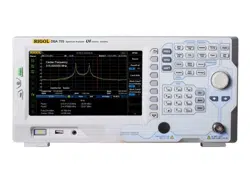Loading ...
Loading ...
Loading ...

RIGOL Chapter 2 Front Panel Operation
User’s Guide for DSA700 Series
2-64
Delta
One of the marker types. It is used to measure the delta values of X (Frequency or
Time) and Y (Amplitude) between the reference point and a certain point on the
trace. When selected, a pair of markers appears on the trace: Reference Marker
(marked by a combination of the marker number and letter "R", such as "1R") and
the Delta Marker (marked by the marker number, such as "1").
Key Points:
A reference marker will be activated at the position of the current marker if an
active marker currently exists; or else both the reference marker and delta
marker will be simultaneously activated at the center frequency.
The location of the reference marker is always fixed (both on the X-axis and
the Y-axis); while the Delta Marker is active. You can use the numeric keys,
knob or direction keys to change the location of the Delta Marker.
The frequency (or time) delta and amplitude delta between the two markers
are displayed at the upper right corner of the screen.
There are two methods for defining a point as the reference point:
a) Open a "Normal" marker and locate it onto a point. Then, switch the
marker type to "Delta"; at this time, this point is the reference point. You
can modify the location of the delta point to achieve delta measurement.
b) Open a "Delta" marker and locate it onto a point. Then, reselect the
Delta menu to locate the reference marker onto this point. You can
modify the location of the delta point to achieve delta measurement.
When the Noise Mkr function under the Marker Fctn menu is activated, the
result of the noise measurement will be corrected automatically and be
normalized to 1 Hz.
The application of "Delta" marker
Measure the signal-noise ratio of single spectrum signal:
Place the reference and delta Markers onto the signal and noise respectively, the
amplitude in the measurement result is the signal-noise ratio.
Loading ...
Loading ...
Loading ...
